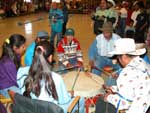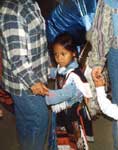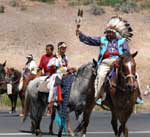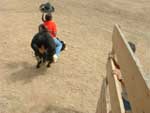 | | A Family Drum providing song. |
Song and dance are among the most important ways we have of celebrating our good-fortune, of offering thanks for those blessings, and of communicating our desires for continued prosperity. With our children and grandmothers beside us, the songs we sing and the dances we do during our ceremonies and other occasions are critical to our way of life. Accompanied by the beat of our hand drums, the songs and dances of our annual Root Feasts, Salmon Feasts, and Huckleberry Feasts are forms of prayer to our Creator. An individual’s day might not begin until he or she has first sung a special song with the rising of the morning sun. A root would not be dug without first singing its song. The cedar fibers for a basket would not be cut until song was first offered. And success in playing a stick game might only be assured by singing the right song.
|
|
Mish Spino and his dad, Roy, talk about the powwow and dancing, with some of the sights and sounds from the Pi-ume-sha Treaty Days Powwow. To better appreciate the movement of the dancers, access this clip at a 512k speed. (Interviewed and filmed by Rodney Frey, June 2003) |
Our dances, with their accompaning songs, overtly demonstrate the pride we have in our ways of life and how we have overcome tremendous challenges to those ways of life. Our dances are times of family growth, as a newborn is welcomed into the community, a child is given its Indian name, or a young couple is brought into their marriage union. Our dances are times of family renewal, as relatives not seen for some time are reacquainted. Our dances, with their songs, are times of family remembrance, as a memorial is given for the passing of a grandmother.
 | | Mish Spino Circle Dancing. |
Our summer powwows are times of great public rejoicing and celebration, in which all are welcomed to attend. With drum groups sitting around their large bass drum, with the MC coordinating the schedule of dances and adding his own form of humor, and with dancers in their particular dance regalia ready to go, an evening’s dance would be opened with the Grand Entry and Honor Song. Held by elders of merit and war veterans, the dancers would follow the Indian flag (an Eagle Feather Staff), United States flag and Tribal flag in order - elders to young, men to women, grouped by their dance style. Throughout the evening, Intertribal Dances, in which all are welcomed to dance, would be augmented by Traditional Men’s and Women’s Dances, Fancy, Grass, and Jingle Dances, among others. As the powwow continues throughout the weekend, various craft and food vendors sell their best to those attending.
By the 1730s, our neighbors to the east, the Cayuse, Nez Perce and Umatilla along the Columbia and lower Snake rivers, and the Northern Shoshone of the upper Snake River, had obtained horses from the Spaniards. And by the mid-1700s we, the Wasco and Warm Springs, and by the early to mid-1800s, we the Northern Paiute, had acquired these new and wonderful animals that would change our lives dramatically. One of the first changes to occur was the frequency, volume and extent of trade enhanced by the horse. While trade was already well developed and integral to the Celilo Falls and The Dalles region, very distant peoples could more easily become a part of that commercial network. The horse extended the reach established by canoe and foot travel. The Crows of Montana, for example, who were already trading partners with the Hidatsa and Mandan of the upper Missouri River, now were linked with the Columbia River network and the Nez Perce. In exchange for horn bows, roots and horses, the highly prized buffalo robes, along with tipis, parfleches and women’s saddles were acquired by our peoples.
|
|
Roy Spino talks about the importance of horses and what his son, Mish, needs to know about them. Also on this video clip are some of the sights and sounds from the 15-mile Endurance Horse Race held during Pi-ume-sha Treaty Days Powwow. (Interviewed and filmed by Rodney Frey, June 2003) |
While certainly valued for its utility, for travel and on hunting trips, the horse is important to us in other ways as well. For many, our herds of horses have become part of our families, with great care and affection shown them and some even given nicknames. We show off our favorite horses at annual parades, with both our riders and the horses outfitted in our best regalia. We like to show off our fastest horses at the annual Pi-ume-sha Horse Endurance Race. For some families, the various rodeos held throughout the year are times to demonstrate our skills in the use of the horse.
Continue your visit with Mish, hitting a home run at a baseball game or salmon fishing along the Deschutes River.
To learn more about the various dances and songs, the regalia, and the etiquette of the powwow, go to a Coeur d'Alene Powwow
© Confederated Tribes of Warm Springs 2003
< previous | next >
|












